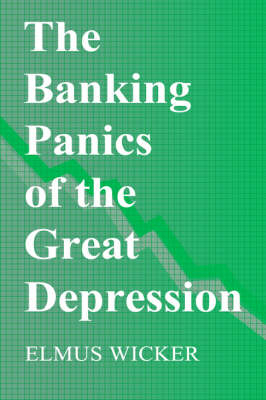
The Banking Panics of the Great Depression
Seiten
1996
Cambridge University Press (Verlag)
978-0-521-56261-4 (ISBN)
Cambridge University Press (Verlag)
978-0-521-56261-4 (ISBN)
The first full-length study of five US banking panics of the Great Depression. Previous studies of the Depression have approached the banking panics from a macroeconomic viewpoint; Professor Wicker reconstructs a close historical narrative of each of the panics, investigating their origins, magnitude, and effects.
This is the first full-length study of five US banking panics of the Great Depression. Previous studies of the Depression have approached the banking panics from a macroeconomic viewpoint; Professor Wicker fills a lacuna in current knowledge by reconstructing a close historical narrative of each of the panics, investigating their origins, magnitude, and effects. He makes a detailed analysis of the geographical incidence of the disturbances using the Federal Reserve District as the basic unit, and reappraises the role of Federal Reserve officials in the panics. His findings challenge many of the commonly held assumptions about the events of 1930 and 1931, for example the belief that the increase in the discount rate in October 1931 initiated a wave of bank suspensions and hoarding. This meticulous account will be of wide interest to students of the Great Depression, monetary and financial historians, financial economists and macroeconomists.
This is the first full-length study of five US banking panics of the Great Depression. Previous studies of the Depression have approached the banking panics from a macroeconomic viewpoint; Professor Wicker fills a lacuna in current knowledge by reconstructing a close historical narrative of each of the panics, investigating their origins, magnitude, and effects. He makes a detailed analysis of the geographical incidence of the disturbances using the Federal Reserve District as the basic unit, and reappraises the role of Federal Reserve officials in the panics. His findings challenge many of the commonly held assumptions about the events of 1930 and 1931, for example the belief that the increase in the discount rate in October 1931 initiated a wave of bank suspensions and hoarding. This meticulous account will be of wide interest to students of the Great Depression, monetary and financial historians, financial economists and macroeconomists.
1. The Banking Situation in the United States, 1921–33.
| Erscheint lt. Verlag | 1.8.1996 |
|---|---|
| Reihe/Serie | Studies in Macroeconomic History |
| Zusatzinfo | 45 Tables, unspecified; 5 Line drawings, unspecified |
| Verlagsort | Cambridge |
| Sprache | englisch |
| Maße | 159 x 236 mm |
| Gewicht | 455 g |
| Themenwelt | Geisteswissenschaften ► Geschichte ► Regional- / Ländergeschichte |
| Geschichte ► Teilgebiete der Geschichte ► Wirtschaftsgeschichte | |
| Wirtschaft ► Betriebswirtschaft / Management ► Finanzierung | |
| Betriebswirtschaft / Management ► Spezielle Betriebswirtschaftslehre ► Bankbetriebslehre | |
| Wirtschaft ► Volkswirtschaftslehre ► Makroökonomie | |
| ISBN-10 | 0-521-56261-9 / 0521562619 |
| ISBN-13 | 978-0-521-56261-4 / 9780521562614 |
| Zustand | Neuware |
| Haben Sie eine Frage zum Produkt? |
Mehr entdecken
aus dem Bereich
aus dem Bereich
die Ukraine, Polen und der Irrweg in der russischen Geschichte
Buch | Hardcover (2023)
C.H.Beck (Verlag)
28,00 €
eine Globalgeschichte des Kapitalismus
Buch | Hardcover (2023)
C.H.Beck (Verlag)
38,00 €


